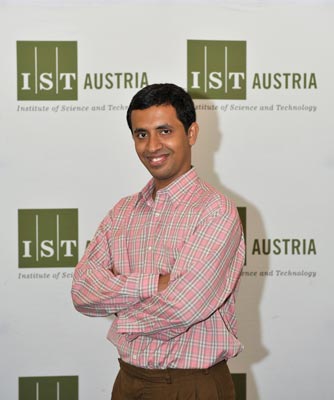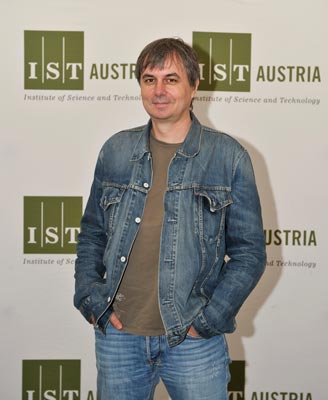June 2, 2009
President Henzinger presents three new Professors
Chatterjee, Edelsbrunner and Heisenberg named at opening ceremony

Krishnendu Chatterjee 
Herbert Edelsbrunner 
Carl-Philipp Heisenberg
Professor Thomas Henzinger, acting as first President of IST Austria, in his presentation on the occasion of the opening of the IST Austria Campus this evening named three further Professors who will join the Institute: Krishnendu Chatterjee, Herbert Edelsbrunner and Carl-Philipp Heisenberg. This puts the numbers of Professors at IST Austria – including Nick Barton and Henzinger himself – to five. Chatterjee is an Assistant Professor on a Tenure Track position, the others signed open-ended contracts as Professors. Chatterjee takes up his new position today, Edelsbrunner on August 1st. Carl-Philipp Heisenberg will start to work at IST Austria February 1st, 2010 and move to Klosterneuburg with his group in full capacity once the Science Lab is available in summer 2010.
Krishnendu Chatterjee, born 1978, is an Indian computer scientist. He studied Computer Science at the Indian Institute of Technology (IIT) Kharagpur, one of the best Indian Technical Universities, before moving to the University of California at Berkeley. There he finished his Master in 2004 and his PhD in 2007. Since 2008 he is a postdoctoral researcher at the University of California at Santa Cruz.
The main field of Chatterjee is verification and control of reactive systems (soft- or hardware). In his PhD thesis he worked on the theory of repeated games. Here, system components are modelled as players in a game or a controller represents one player and the reacting system another player in a sequence of rounds. The results of his work contribute to our knowledge about stochastic games and the existence of Nash equilibria. Since his postdoctoral appointment he continues research in verification and game theory, but in addition works on a reputation and trust management system for Wikipedia.
Chatterjee won the President of India Gold Medal as the best IIT student of the year and the prestigious Ackerman Award for the best thesis worldwide in computer science logic. His scientific productivity is extraordinary: The DBLP database lists 67 articles co-authored by him, many of them in the most prestigious journals and conference proceedings.
Herbert Edelsbrunner was born in Graz 1958. He studied Technical Mathematics at the Graz University of Technology where he finished his PhD in 1982. In 1985, he moved to the University of Illinois at Urbana-Champaign, where he was Assistant Professor, than Associate Professor and, from 1990, Full Professor. Since 1999 he is Professor of Computer Science at Duke University (Durham, North Carolina) with a secondary appointment in the Department of Mathematics. He was visiting professor at Hong Kong University of Science and Technology, Lawrence Livermoore National Lab, Ecole Normale Superieure (Paris) and Berlin Mathematical School.
Edelsbrunner worked on various problems in mathematics and computer science with strong links to other areas: computational geometry and topology, algorithms and data structures, geometric modelling, and computational structural biology. In the future, he plans to continue work along a connected chain from the foundations of computational topology over algorithms and software to applications. Candidate areas for fruitful collaborations include systems biology and materials science.
Edelsbrunner is considered to be one of the leading researchers in computational geometry and the founding father and a leading figure in computational topology. He is well known for the development of Alpha Shapes, a method for restructuring any shape or surface from an unorganized set of 3D data points, and for his analysis of protein geometry. He is author of several text books in algorithmic geometry and of 132 publications in scientific journals. He is included in the list of “highly cited” computer scientists worldwide. Edelsbrunner received numerous Awards and Honours, among them the Alan T. Waterman Award from the National Science Foundation and a Honorary Doctorate from Graz University of Technology. He is a member of the American Academy of Arts and Sciences. Together with his wife he started the successful software company Raindrop Geomagic which is based on theories and algorithms developed by him.
Carl-Philipp Heisenberg, born in 1968, is a German citizen. He studied Biology at the Ludwig-Maximilians-Universität München and finished his PhD in 1996 at the MPI for Developmental Biology in Tübingen in the group of Nobelist Christiane Nüsslein-Volhard. After performing postdoctoral studies at the King’s College London/University College London he returned to Germany to the MPI of Molecular Cell Biology and Genetics in Dresden in 2000, where he was group leader, Emmy-Noether fellow and is member of the Senior Faculty.
Heisenberg is interested in the molecular and cellular mechanisms underlying morphogenesis in vertebrate development using zebra fish embryos as a model system. He accomplished important work on endocytic trafficking, cell type specification in different germ layers and the role of Wnt signalling in controlling cell movement. Adapting the use of different biophysical tools such as high-resolution two-photon confocal imaging of single progenitor cells and atomic force microscopy in collaboration with other groups, he provided important insights into more physical aspects of cell behaviour. His approach to morphogenesis is mathematical and physical and therefore special in combining a highly quantitative and theoretical viewpoint of problems in cell and developmental biology.
His productivity in the 8 years since he became an independent researcher is impressive, not only in quantity, but also in quality. He published so far more than 60 articles, many of them in leading journals of the respective fields. He is considered to be one of the internationally outstanding young scientists at the interface between Cell and Developmental Biology.





